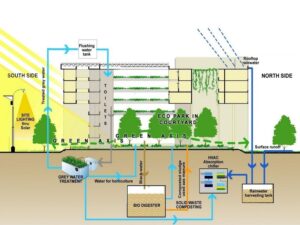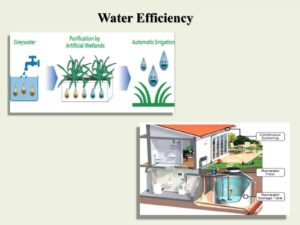The history of architectural discourse in the last few decades in South Asia, is replete with references to many architects who in their buildings espoused a sustainable or an ecological sensitive approach to their design. These handful of architects have been a source of reference and inspiration for generation of architects and in their own small ways many new generation of practices continue this great traditions. However most such practices are “boutique” in nature and very few have the impact at larger scale and volumes. So the pursuit of the “green” often ends up being a private indulgence of a few thereby resulting in sidelining of the larger issue of sustainable development.
 Photo courtesy: Re-thinking the future
Photo courtesy: Re-thinking the future
The climate crisis is perhaps the single most important moment in history in recent times and it would demand new ways of imagination and practice. The two areas that will need a lot of attention would be architectural education and building bye laws. For example the question of green buildings or sustainable development cannot be now limited to a few courses “environment and ecology” but will need to have an overarching effect on all the courses that are taught. The aim should be to inculcate a “habit” amongst young students of thinking about sustainability. One might begin by asking tough questions such as “Do we really need to built? Or can I not reuse an existing rather than built?” And how does one structure studio courses or even construction courses so that working with less and being sensitive to environment almost becomes second nature to students. There is a lot of possibility to relook at both curriculum and pedagogy in architectural schools.
 Photo courtesy: slideshare.net
Photo courtesy: slideshare.net
Whereas we do find many architectural graduate enter the world of practice with idealism in their eyes, but soon they surrender themselves to the demands of the practice that caters to new development. In the absence of effective bye- laws that incentivise green building, it is impossible to have any major impact on the climate and the question of sustainability will remain a lip service. Building material energy ratings, predictive models for estimating energy consumption in proposed buildings would be the first step towards incorporating the same in building blue laws. This would need a major redesign of building bye laws and its implementation. However, one may begin from offering tax waivers to properties that demonstrate sustainable construction practices. A good simple manual for architects and builders can be the first step in this direction. But perhaps a real beginning can and should be made in all the construction undertaken by government departments and local bodies. These can then become role models examples of “green buildings” for the rest of the architects and developer community to emulate.
 Neerain is proud to republish this article for spreading awareness about situation of water, for our stakeholders. Credit whatsoever goes to the Author.
Neerain is proud to republish this article for spreading awareness about situation of water, for our stakeholders. Credit whatsoever goes to the Author.
This article is published by: –
SOCLEEN MAGAZINE – FEBRUARY 2023
We would like to spread this for the benefit of fellow Indians.
Author: Prof. Pratyush Shankar
Publish On: February 2023
